Last-Minute NYC Holiday Gift Guide 🎁
We’ve created a holiday gift guide with presents for the intrepid New Yorker that should arrive just in time—


The exhibition planners of the 1939/1940 World’s Fair in New York City wanted it to be “the greatest international exposition in history.” The fair was attended by 60 nations, 33 states and U.S. territories, and over a thousand exhibitors, plus 45 million visitors over the course of its two seasons. It turned out to be the best-attended event of the first half of the 20th century, but it is often overshadowed by more recent memories of the 1964/1965 World’s Fair which we still see notable remnants of in the form of Philip Johnson’s New York State Pavilion, the Unisphere and other buildings still standing in Flushing Meadows-Corona Park.
Missing from the park today are the two distinctive structures that served as the symbols of the 1939 fair, a towering 610-foot Trylon and an imposing 200-foot Perisphere. Here we’ve compiled 10 interesting facts about those two long-gone icons.

Didn't make it to the 1939/40 or 1964/65 fairs? Here's your chance!
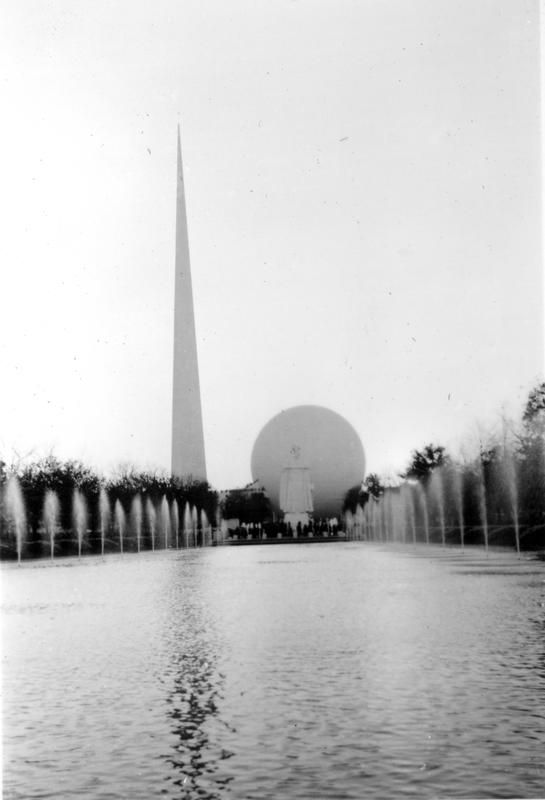
Photograph Courtesy of NYC Parks Archives
Standing at 610 feet tall, the pointy Trylon tower was the tallest structure at the fair and one of, if not the tallest building in Queens at the time. The Trylon and Perisphere were so tall that they could be seen all the way from midtown Manhattan and even parts of the Bronx! This worked out as a great marketing tool, as people who saw the structures from far away were intrigued to visit the fair and see them up close.
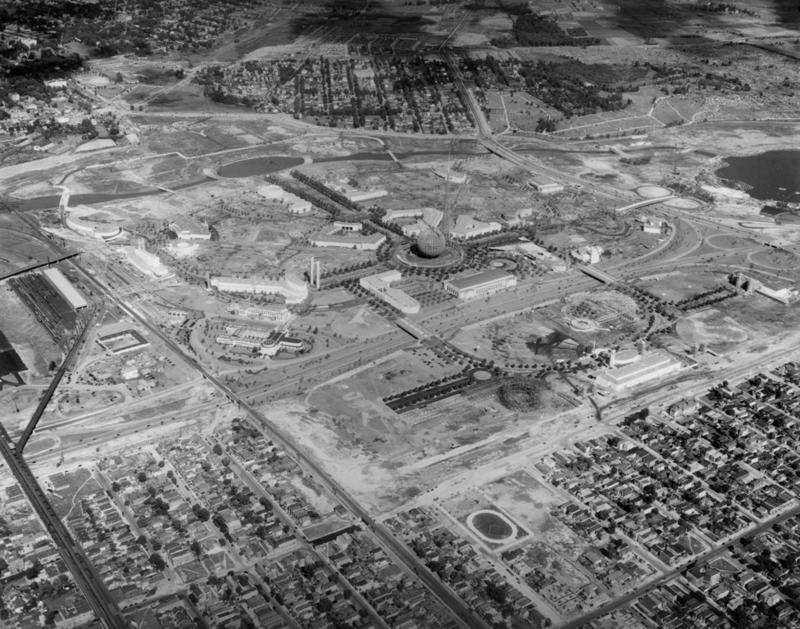
Photograph Courtesy of NYC Parks Archives
It took 2,000 cubic yards of concrete and reinforced steel, more than 7,000 individual pieces, to create the Trylon and Perisphere. Their combined weight came to approximately 10,000 tons! The Perisphere stood 18 stories tall with a circumference of 628 feet and the Trylon reached 610 feet high. In order to test the durability of the design, models were subjected to 70-mile an hour winds in a test tunnel.
Fair planners wanted to create structures that would rival the Eiffel Tower in France which was built for the Universal Exposition of 1889. After considering many different designs the Trylon and Perisphere were selected for their strikingly unusual yet simple shapes, which embodied the future facing atmosphere of the fair.

Image via Wikimedia Commons from New York Public Library
“Building the World of Tomorrow” was the theme of the 1939 World’s Fair, so the centerpiece of the event had to have a streamlined and futuristic design. The Trylon and Persisphere, two contrasting yet simple geometric shapes, were designed by architects Wallace K. Harrison and Jacques-André Fouilhoux. Harrison would go on to be the leading architect of the United Nations Headquarters.
The original plans for the Perisphere called for it to be covered in a smooth and seamless layer of concrete. However, due to the high cost of that material, gypsum was used instead. Unfortunately, despite the best efforts to smooth it out, the gypsum created an uneven texture and had visible seams. Also, surrounding fountains damaged the fragile coating and their arches of water had to be lowered.
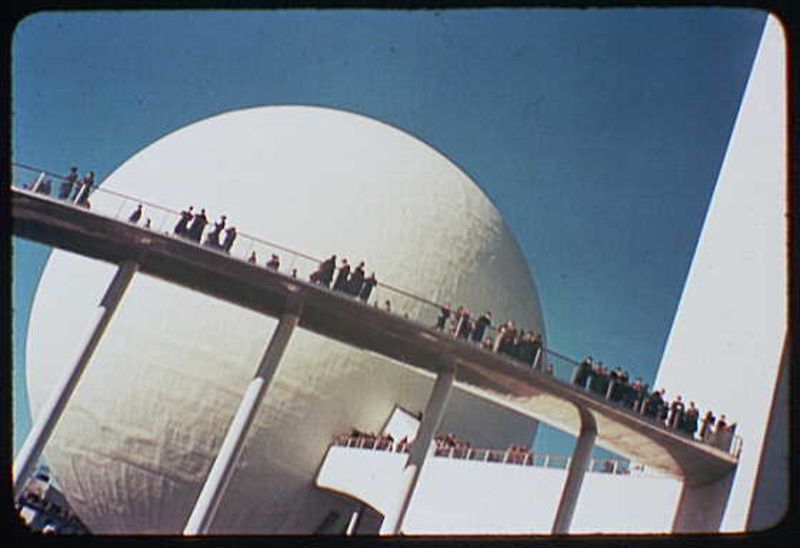
Image via Wikimedia Commons from Library of Congress
To enter the Perisphere and get a look at the exhibit inside visitors had to first enter the Trylon and take a ride up a custom made escalator. The escalator into the Perisphere was the longest electric escalator in the world at that time. Once visitors were done inside, they descended via The Helicline. The Helicline was a 950-foot-long, 18-foot-wide curved ramp with a mirrored underside, that led visitors back down to ground level. Since it was one of the highest open-air areas at the fair, the Helicline was a popular spot to take in views of the fairgrounds.
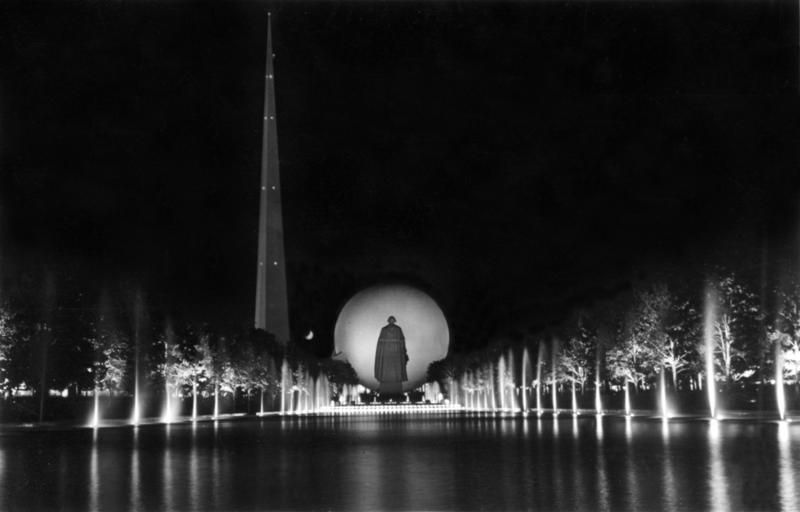
Photograph Courtesy of NYC Parks Archives
The Perisphere was not only a striking feat of architecture from the outside, inside there was an equally stunning exhibit. Democracity was a giant diorama of the ideal city of the future, designed by industrial designer Henry Dreyfuss. The exhibit was housed in a space more than two-times the size of Radio City Music Hall. After paying twenty-five cents, visitors viewed the exhibit from two rotating balconies, dubbed “magic carpets,” that encircled the model. Every six-minutes a recorded narration would extoll the wonders of this utopian city and the lights would dim to mimic nighttime as phosphorescent paint made the buildings look like they were lighting up from the inside. The narration was accompanied by the theme song “Rising Tide” by William Grant Still.
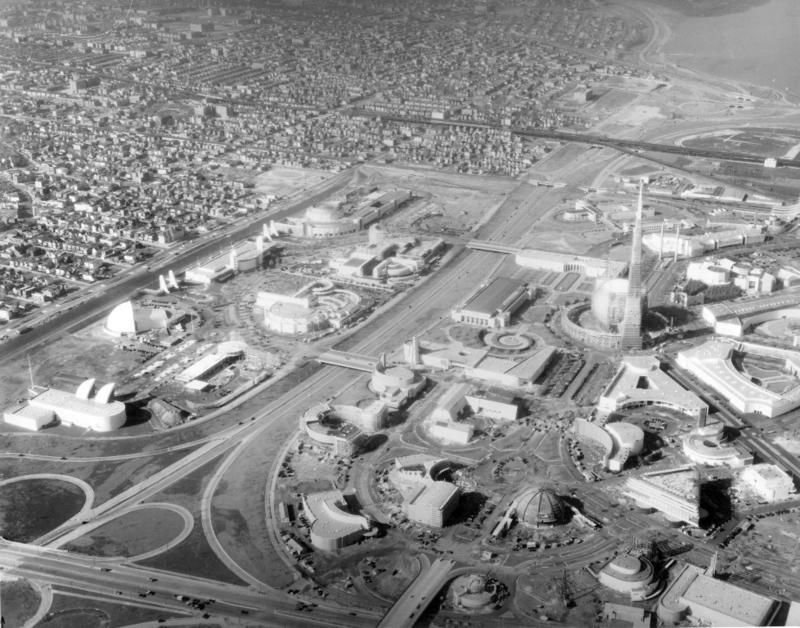 Photograph Courtesy of NYC Parks Archives
Photograph Courtesy of NYC Parks Archives
The design for the Perisphere called for eight relatively small pylons for support, but they were to be hidden to give the illusion that the orb was floating. This was accomplished by strategically placed fountains and covering the supports with mirrors. At first, the fountains didn’t provide enough coverage, but their pressure was increased and more were added to create the desired effect.
 Photograph Courtesy of NYC Parks Archives
Photograph Courtesy of NYC Parks Archives
At night, moving images of clouds and other images were projected from nearby exhibit buildings onto the Perisphere using a specially designed glass-mounted slides. The amount of light needed to project the images would have burned through regular film, so film slides were enclosed in glass. A new type of projector with a custom designed battery and the largest long-focus lenses ever commercially made were created to facilitate the Perisphere’s projections.
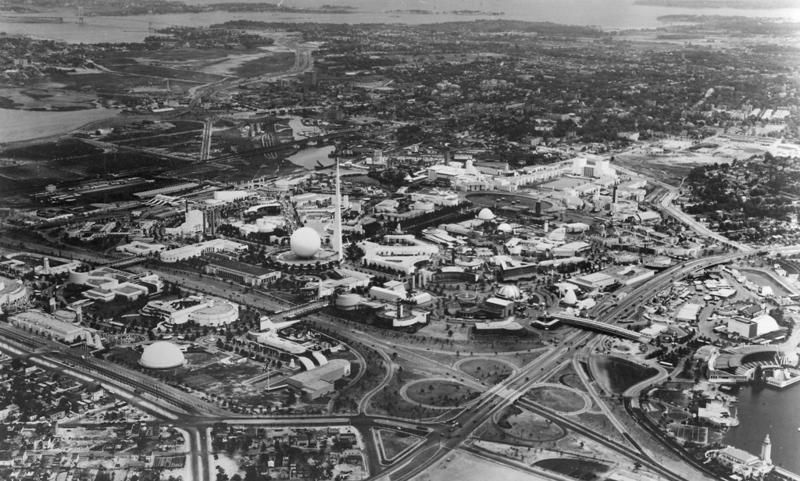 1939 World’s Fair. Photo Courtesy of NYC Parks Archives
1939 World’s Fair. Photo Courtesy of NYC Parks Archives
The striking design of Trylon and Perisphere made them easily recognizable and popular icons of the fair. Their image was licensed for use on an estimated 25,000 products. In 1939, licensing such as this was a relatively new concept, but it still it earned the fair $1 million in the first season alone.
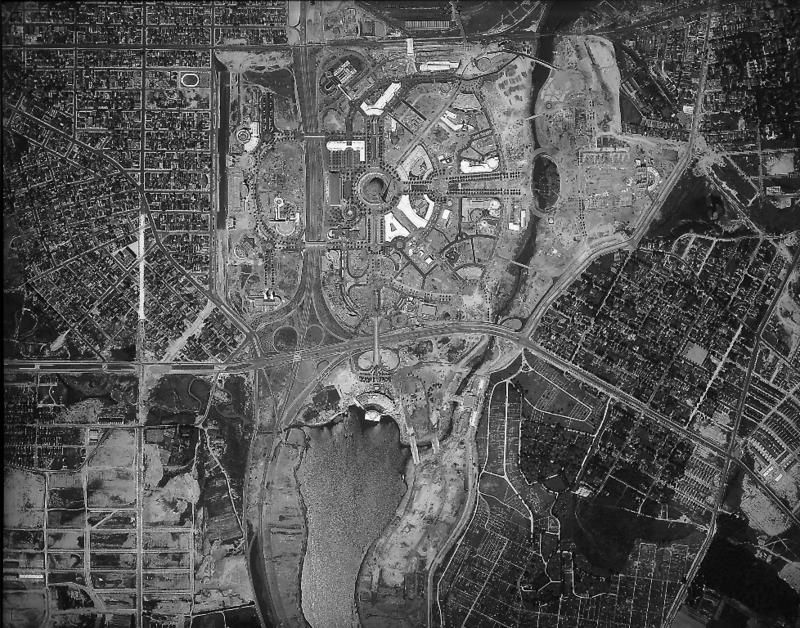 Photograph Courtesy of NYC Parks Archives
Photograph Courtesy of NYC Parks Archives
October 27, 1940 was the last day of the fair and the highest day of attendance with over 550,000 visitors. However, overall attendance lagged far behind the 1939 season and profits made in 1940 couldn’t make up for the debts of the previous year. Demolition of the fair site began the day after the gates closed. It is possible that parts of the Trylon and Perisphere were sold to make armaments for World War II.
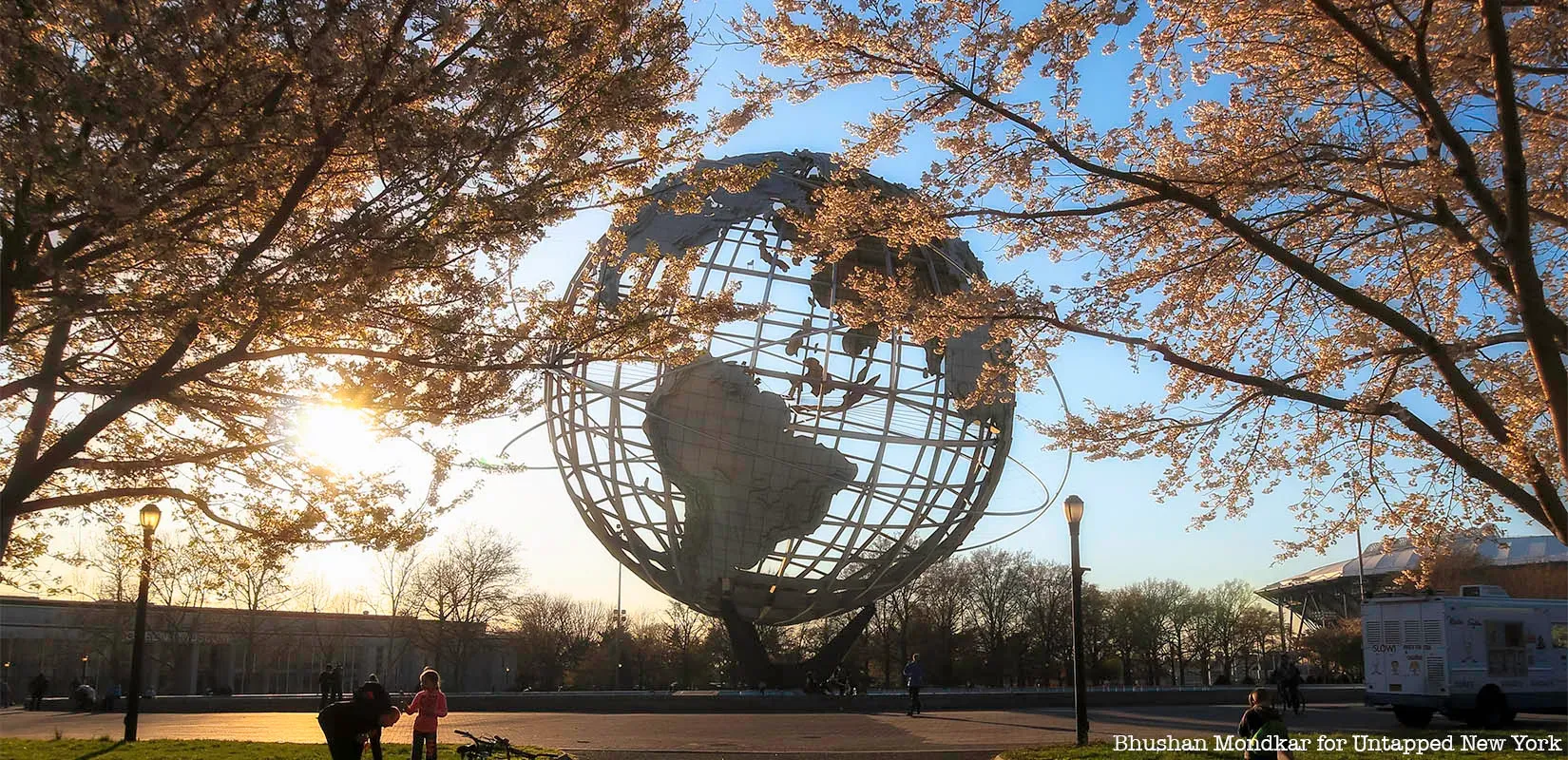
Marking the location of where the Perisphere once stood is the massive globe structure from the 1964/1965 World’s Fair, the Unisphere. The Unisphere was designed by landscape architect Gilmore D. Clarke and erected by the American Bridge Division of the United States Steel Corporation. Like the Perisphere before it, the Unisphere was the central figure of the fair. It weighs in at 350-tons and has a 120-foot-diameter.
Subscribe to our newsletter